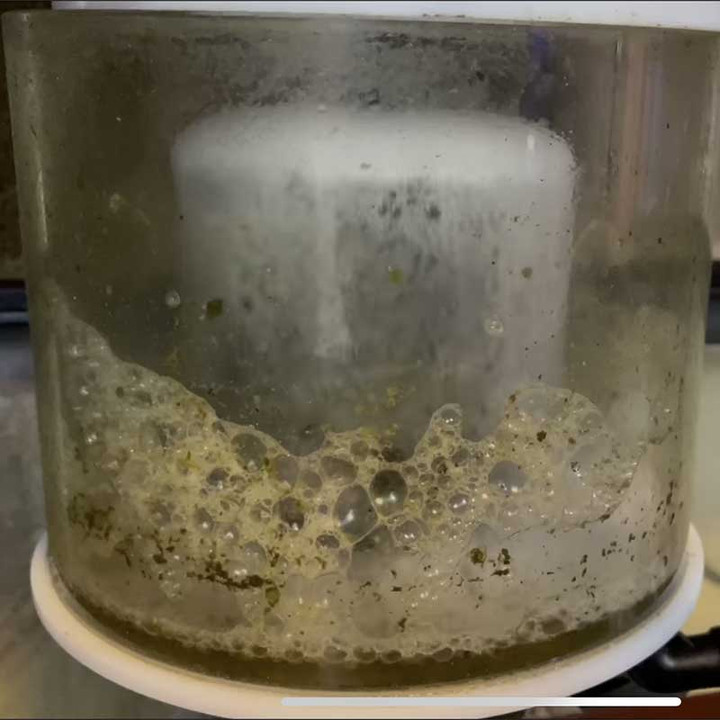Wet Skimming Strategies for Cleaning Up Your Reef Tank
Hello citizens of the world. Can you spare a minute or two to talk about your Lord and Savior, wet skimming?
No, I’m not going to proselytize to you about reef keeping methods, but I will do my best to explain it to you.
Wet skimming is basically running your skimmer so the foam head is right up near the top of the neck. Skimmate (that’s what the liquid is called that your skimmer pulls out) falls into the collection cup at a much faster rate than normal. This is something you could do for several days (as Richard describes in Reef Beef episode 9) or my approach, just during a routine maintenance.
In Richard‘s case, though his display tank is somewhere around 150 gallons, it’s tied to a total system volume of probably around 400 gallons. He’ll run his skimmer to where he collects a drop or two every few seconds or so. He closely monitors his salinity to make sure there is very little change while he does this over the course of several days.
Since I own a maintenance company, my approach is different. Wet skimming is a particular strategy I might employ depending on what I see when I first walk up to an aquarium. I might use my gravel vac a little bit, I might use a thin diameter silicone tube to pick up algae, or I might wet skim a little bit....or not at all. It really depends on the time constraints and the condition of the aquarium.
First, I disable the automatic top off on a system so as not to trigger it while I’m doing my thing. I will have buckets filled with premixed salt water ready to go around me as I tune up the skimmer and cause it to puke out into the collection cup. I always use skimmers that have a drainage nipple on the collection cup onto which I affix several feet of 3/8ths silicone tubing. I’ll have a clamp or tiny ball valve at the end of that tubing during normal operation so skimmate stays in the collection cup, or more often than not, I’ll have that hose running to an Avast Marine skimmate locker. Just google that if you don’t know what it is. I love them. So during this process, I put the tube from the skimmer collection cup into a 7 gallon bucket in order to collect the skimmate. At this point I’ll kick up detritus in the system by swishing my hand in the tank forcefully, stirring up the substrate with some sort of implement as well. Your skimmer will remove lots of this really fine debris that has been kicked up into the water. Be sure your internal circulation pumps (Sicce Voyager, Ecotech Vortech, Red Sea Gyre) are kicked up in order to keep this debris in circulation while you do this.
I then pour saltwater into the tank, from above, or into the sump, near the main pump. I wouldn’t pour it around the skimmer because I’m wanting older water to be spit out by the skimmer. Invariably you’ll get some of the new water removed but that’s unavoidable, you just want it to be as little as possible. The rate at which your skimmer is spilling over needs to be closely watched as you do this. Depending how big your sump is and how it is built, you could make the skimmer puke before you put any new water in. What you don’t want to do is have the skimmer just puke out so much water so fast, it fills the cup and overflows faster than the drain line can send it to your bucket.
Let me back up a second to address something; build up of proteins and “gunk” on the skimmer neck’s wall. Remove the skimmer head and clean it in the sink before you do this. When I first started using this method many years ago, I thought I could use a bristle brush while the skimmer puked to knock off all the debris coating the neck. I figured the skimmer would just push it right out as it puked. It doesn’t work that way unfortunately. The skimmer will draw chunks of it down into the body, much of it indeed getting puked out but also a lot getting kicked out of the skimmer, into the sump. Clean the head at a sink first.
So in our Reef Beef episode 9 video on YouTube, Richard talks about how he barely lets it drip out of the collection cup. The way I do it, I want bubbles pouring over the neck of the skimmer and out into the bucket. Mind you I don’t want it pouring so fast that it just looks like water pouring over. I’m looking for frothy bubbles here. So I keep a close eye on the water level in the sump vs modulating the skimmer to give me the level of “puking” I’m looking for. It’s a careful dance between modulating the skimmer and topping off with new saltwater. Once you get the hang of it, it’s no big deal. Obviously I don’t want the main pump running dry and cavitating, nor do I want the skimmer pump doing the same. Add new water as needed to keep the process going.
Sometimes I’ll gravel vac out 2 buckets and then add back 3 buckets of new water, wet skimming out that 3rd bucket, or some other similar combination. Sometimes I’ll do all the water change as a wet skim too.
I hope this helps you keep your reef in better shape and gives you more tools to fight aquarium problems. Please watch our Reef Beef video episode 9 if you would like to listen to Richard and I explain our different approaches on this. Thanks!
Explore Popular Articles
-
ReefStock Denver is This Weekend!
Feb 27, 2024The time is finally here. Reef Builders ReefStock Show is coming to the Crowne Plaza Hotel in Denve
-
Sicce's New Scuba Heater!
Oct 23, 20235 Year Warranty, High Quality Italian Made, A Heater for the FUTURE! Innovative heater range eq
-
Current USA R24 LOOP LED
Oct 23, 2023Compact lighting with SPS coral growing power. For those who love the Orbit® Marine, the Orbit® R




